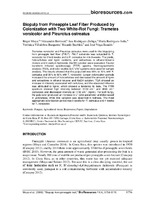Biopulp from pineapple leaf fiber produced by colonization with two white-rot fungi: Trametes versicolor and Pleurotus ostreatus

Date
2016Author
Rodríguez-Zúñiga, Ana
Rodriguez-Solis, María
Villalobos-Barquero, Verónica
Vega-Baudrit, José
Moya-Roque, Róger
Berrocal-Jiménez, Alexander
Starbird-Pérez, Ricardo
Metadata
Show full item recordAbstract
Trametes versicolor and Pleurotus ostreatus were used for the biopulping from pineapple leaf fiber (PALF). PALF substrate was subjected to T. versicolor for 2 to 6 weeks and to P. ostreatus for 4 to 8 weeks. The yields, holocellulose and lignin contents, and extractives in ethanol-toluene mixture and in sodium hydroxide (NaOH) solution were evaluated. Fourier transform infrared spectroscopy (FTIR) spectra, thermogravimetric analysis (TGA), and color studies by L*a*b* systems were used for sample analysis. The results showed that the pulp yield was 55% to 70% with P. ostreatus and 35% to 50% with T. versicolor. Longer colonization periods increased the amount of holocellulose and decreased the amount of lignin and extractives in ethanol-toluene and NaOH solution. TGA showed an increase in intensity associated with cellulose, and the observed inflexion was attributed to lignin, which showed a tendency to fade. The FTIR spectrum showed high intensity between 3100 cm-1 and 3600 cm-1 (cellulose) and decreased intensity at 1730 cm-1 (lignin). For both fungi, the pulp color produced an increase in L* color parameter and decreased in yellowness, while little variation was observed in redness. The most appropriate colonization period was 5 weeks for P. ostreatus and 4 weeks for T. versicolor.
Description
Artículo científico
Source
BioResourcesShare
Metrics
Collections
- Artículos [36]

